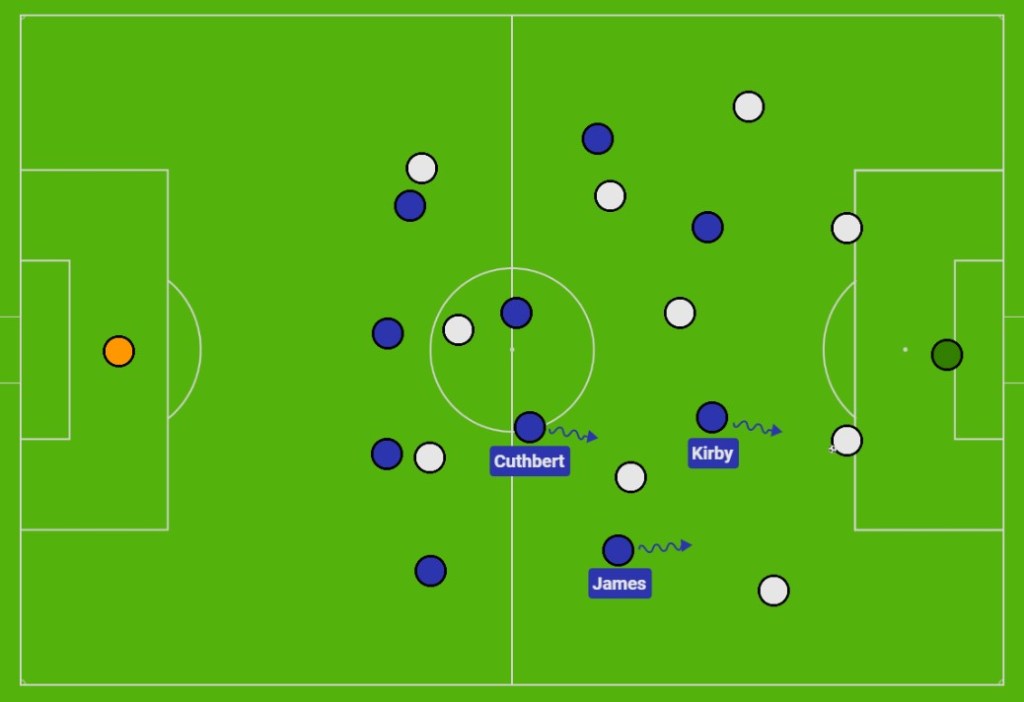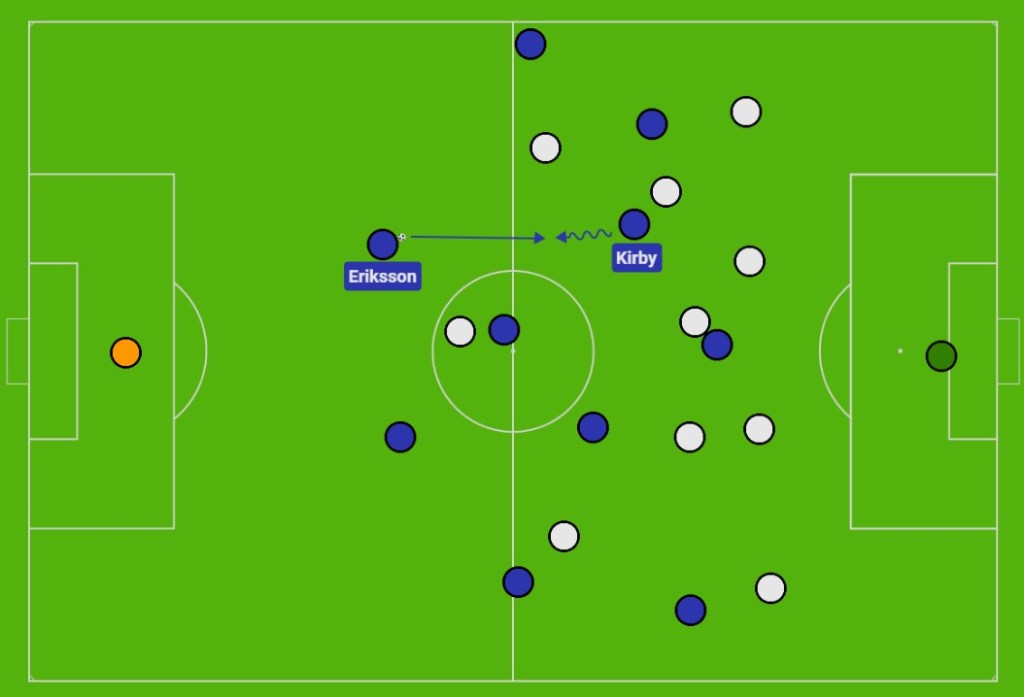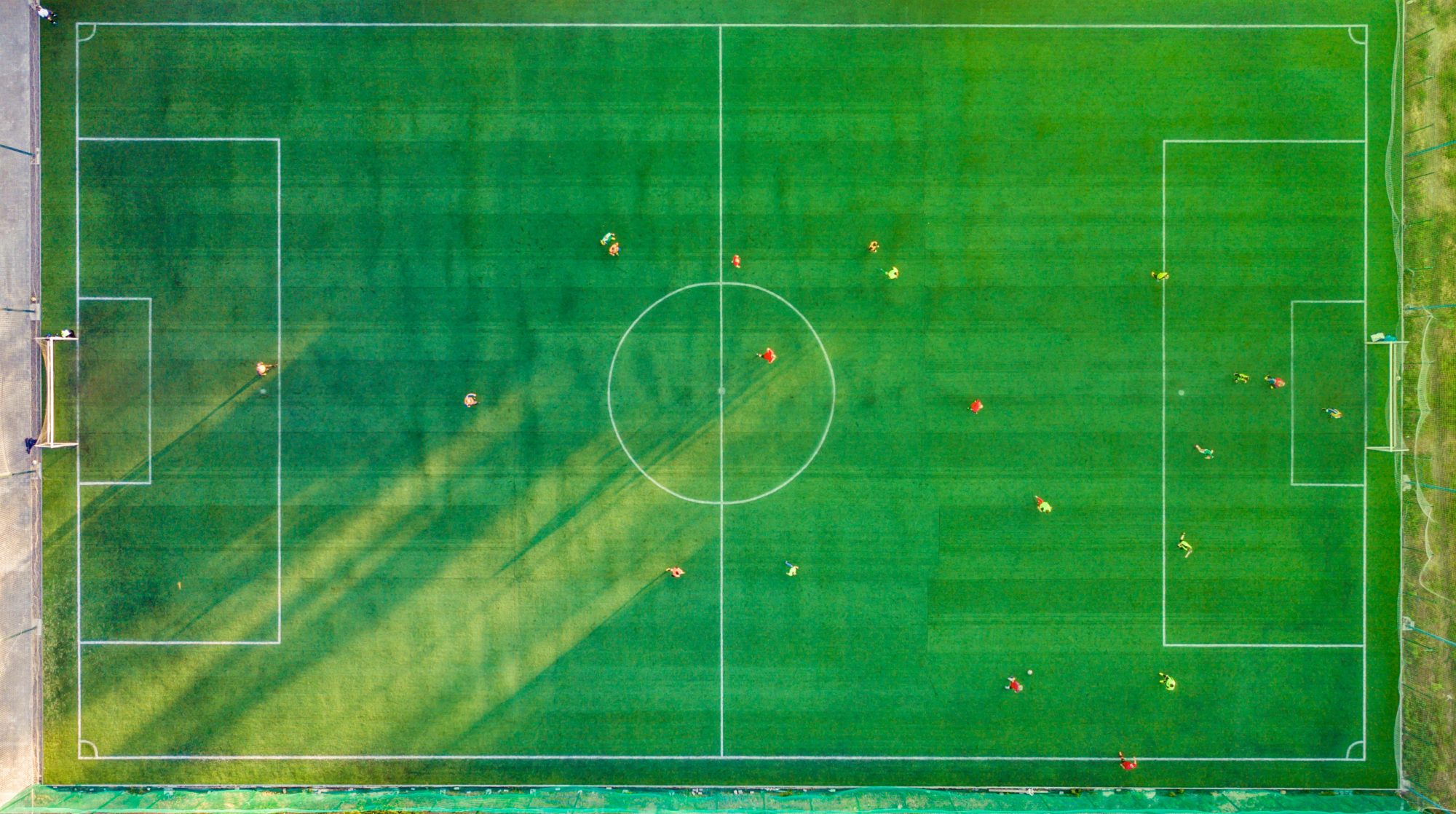Over the past decade, few managers in the world of football have achieved more than Emma Hayes at Chelsea. Having now won the FA Cup and WSL title in back to back seasons with the Blues, the Chelsea legend will now have her eyes on the greatest prize of all in club football – the UEFA Champions League. Fortunately for her, Chelsea are in the form of their lives at the moment, and currently boast what is possibly the greatest squad they’ve ever had. The likes of Lyon and Barcelona will be difficult to beat, but Chelsea are in good shape to go this season with a near unbeaten record, and challenge for that elusive trophy once and for all. Here is our analysis of Emma Hayes’ Chelsea in 2022-23.
SYSTEM OF PLAY: 4-2-3-1

Across several previous campaigns, Emma Hayes became synonymous with the back-three, in a similar vein to Antonio Conte. She made the 3-4-1-2 her own, but remained flexible in adapting depending on the personnel available and the opposition’s set-up.
Now into 2022-23, Emma Hayes has primarily deployed the 4-2-3-1, whilst remaining similarly adaptable. Chelsea have employed a 3-4-2-1, 3-4-1-2 and 4-3-3 at times this season, but have looked the most settled and comfortable in that 4-2-3-1.
Embed from Getty ImagesPart of the inclination to even continue in a back-three might be to fit all of their star-studded defenders into the same side. Kadeisha Buchanan made a big money move from Lyon in the summer, but was always going to be fighting an uphill battle to break the partnership between Bright and Eriksson. The defensive pairing are not only vice-captain and captain respectively, but have existed together as part of Hayes’ back-line for the majority of her reign in charge of the club.
Embed from Getty ImagesEriksson can also play left-back whenever Hayes wants to opt for something different, but the fullbacks at the club also remain of the highest quality. Niamh Charles has hardly missed a game all season and offers more of an attacking presence than the Swedish captain, as does French fullback Ève Périsset, who arrived from Bordeaux in the summer. Lauren James can add some additional attacking flair as a right-wing-back in a back-three, and then you have Jess Carter and Aniek Nouwen knocking at the door. The selection headache for Hayes at the back must be massive, but it’s a relatively good problem to have.
Embed from Getty ImagesThose selection headaches only continue when you get into the midfield, as Canadian Player of the Year Jessie Fleming cannot accumulate enough minutes to truly solidify a place in the side. That’s down to the stellar partnership between Sophie Ingle as more of an ‘Anchor’ and Erin Cuthbert playing somewhere between a ‘Deep-Lying-Playmaker’ and an adventurous ‘Box to Box Midfielder’.
Embed from Getty ImagesAhead of the fantastic double midfield pivot, you have the one and only Fran Kirby, the key playmaker in the team responsible for creating the vast majority of the team’s best chances. She often operates in close proximity to Guro Reiten who works best as an ‘Inverted Winger’, and loves to play progressive passes in behind the defense for Kirby or Kerr to run onto. The right wing is more open for debate, and could see Jelena Čanković, Johanna Kaneryd, or Lauren James bombing down the wide areas and working their magic.
Embed from Getty ImagesJames provides a nice contrast to Reiten’s imagination on the other side, offering an out-and-out direct speed threat down the right. Čanković and Kaneyrd are more astute when it comes to reading the game and assessing pockets of space to envelop, before working their magic in combination with Kirby and Kerr. Čanković is a particularly decisive goal-scoring threat, and could grow into the side as she learns the trade. Pernille Harder could also come back into the mix in the second half season to compound misery for everyone else, as she recovers from a hamstring injury.
Embed from Getty ImagesAs if that’s not already enough, Chelsea have their own version of Erling Haaland in the form of Australian striker Sam Kerr, who fulfills so many different roles in the span of a game. Her link-up play is exceptional, but she’s also one of the best in the world at running the channels and finishing off chances. Beth England has had to sadly bide her time from the bench this season, although her goals per 90 numbers remain impressive.
Even if Chelsea want to dip their toes into the transfer market to solidify their squad, it’s difficult to see room for improvement. The re-introduction of Pernille Harder might mean they resort to that back-three more regularly, ensuring they can more naturally fit the two number ten’s of Harder and Kirby into the same system. But for now, it’s becoming increasingly difficult for players like Čankovic, Mjelde or Nouwen to even see minutes on the pitch, under the magnificence the rest of the squad possesses.
DEFENSIVE PRINCIPLES
Embed from Getty ImagesChelsea defend from the front in a shape that closely matches their formation (such as a 4-2-3-1 or 3-4-1-2). In the 4-2-3-1, Kirby can also float up into a 4-4-2 as they press the opposition’s centre-backs. This will occur most commonly in Chelsea’s mid-block when the opposition have more room to circulate the ball further away from their own goal.

In covering additional gaps, Erin Cuthbert may also step up from her right-sided position, creating something of a 4-1-3-2 as they work to counter-act shorter progression and force the opposition long.
But more importantly than the shape is the intensity. The likes of Kerr, Kirby, Reiten and James just embody this all-out warrior mentality and a desire to win the ball at all costs. They always appear hungry to win the ball back out of possession, and have scored several goals this season off the back of their intense pressure.
This goes for their counter-pressing as well, with numbers closest to the situation immediately swarming around the ball. This is particularly imperative given that their rest-defense typically remains a meek 2+1, meaning that their wide areas can be exposed on the break. If the forwards are not diligent in immediately winning back possession, problems can ensue. In fact, this is how Chelsea have conceded some of the only goals (and chances) scored against them this season. The high position of Niamh Charles is often the one most exposed, and a back-three naturally helps to reduce that concern in a way that a back-four (or a 2+1 rest-defense) fails to accomplish.
When they have enough time to set up their defensive structures, both Cuthbert and Ingle are quite exceptional in reducing space and popping up in the right place to break up the play. Cuthbert nicely shuttles down the wide areas to ensure her fullbacks have coverage, and Ingle often nicely anchors in front of the defensive line to screen an opposition ’10’ or ‘9’.
Embed from Getty ImagesPérisset, Charles and Reiten are all magnificent when it comes to tackling and defending in the wide areas, and it’s difficult to dominate the wings against Chelsea when they have enough time to set up shop.
Through the centre is also difficult to combat, as both Bright and Buchanan are positionally savvy enough to cover for one another on passes split through the defense.

That also requires the opposition to gain enough of a foothold over the match rather than just simply trying to play on the break. The Blues have dominated 61.1% of the possession in league play this season, despite still boasting 12.3 successful tackles per match, the third most in the division. That pinpoints exactly what they excel at so wonderfully well in breaking up play early and immediately.
Embed from Getty ImagesAnn Katrin-Berger’s hardly been called upon all season, and has been impressive in posting a 76% save percentage when required. Berger’s not much of a ‘Sweeper Keeper’, so it’s helped in adding a bit of extra pace and pizzazz from Kadeisha Buchanan in helping to cover those gaps. Nevertheless, Bright and Eriksson have actually looked the most comfortable covering those long-passes over the top and ushering play away from danger, as Buchanan adjusts to life in London. But as far as Berger goes, her inactivity in goal remains the nature of being a goalkeeper in an Emma Hayes team. They will always prioritize the attacking side of the game, and dominate possession to extreme heights.
ATTACKING PRINCIPLES
Embed from Getty ImagesIt’s in the attack where Chelsea are always ready to make their mark on a match. Crucial to the process is Fran Kirby, who the Blues endeavour to get on the ball at every opportunity.
That means that when they build out from the back, Kirby can often be a target of progressive passes through the thirds, particularly as she drifts into the half-spaces to receive. This may mean that someone like Erin Cuthbert shifts wide to open up space for the British attacker to receive, or that Kirby will operate around the same height as the right-central midfielder herself. Either way it’s magnificent to see the Chelsea legend fit and healthy again, and playing some of her best stuff once more.

Beyond trying to find Kirby out from the back, Chelsea can intermix moments of patience with moments of dominating progressiveness, utilizing a range of nifty maneuvers to break the opposition. The centre-backs will often circulate the ball in a pendulum swinging motion across their 2+3 to 2+4 shape, getting the ball quickly from one side to the other in the quest to move the opposition.
But they also nicely play up-back-and-through out from the back on the regular, using their central midfielders to draw pressure and then the centre-backs to bounce passes into the likes of Kirby or Kerr in behind. This is rudimentary, but so incredibly effective when done with the precise level of quickness, intensity and quality that Chelsea produce.

Millie Bright has long been a player to enjoy the occasional long loop over the top. She’s attempted more long passes than anyone this season, but posts up the second worst ratio of regulars in the team. Fran Kirby or even Kadeisha Buchanan have been more successful in getting the right weight of pass behind their long passing thrusts, and perhaps Bright should hand over the mantle more regularly.
Embed from Getty ImagesFor now, Kadeisha Buchanan remains far more likely to look for moments in which she can progressively carry the ball up the pitch into space, before luring the opposition in and playing a pass. It’s the likes of Magda Eriksson, Sophie Ingle and Millie Bright more likely to play those long passes over the top, or Erin Cuthbert as a ‘Deep-Lying-Playmaker, often dictating the tempo of the match.

Higher up the pitch, they just have electricity, creativity, and imagination all across the final third. Sam Kerr is fantastic at any aspect of the game you want her to be, consistently running the channels, while also supremely holding up the ball and playing through passes in behind for others. Kirby loves to drift out to the half-spaces, and will frequently run beyond Guro Reiten as the Norwegian winger plays passes into the penalty area.

This tremendously benefits both players, as it allows Reiten to create moments of magic and incisiveness through tiny gaps from the left-half-spaces, while allowing Kirby to create chances closer to goal when the opposition find themselves frantically searching for answers.

Erin Cuthbert also loves to join in on the fun with the help of Sophie Ingle holding rank in behind. Cuthbert has the engine and stamina to consistently venture box-to-box, and the quality in the final third to deliver into the box for fun. With the likes of Kirby, James, Cuthbert, Kerr and Reiten all operating in close proximity, the Blues excel in playing one-touch passes quickly between them all the way into the penalty area.
Despite all the competition in the squad, I’m even hoping that Jelena Čanković grows into her role at the club, as you can already tell just how quickly she makes intelligent decisions on the pitch. She’s keenly aware of what spaces to adopt and how to enact her brilliance in the final third to finish off chances, currently boasting a goals per 90 ratio of 1.42. Fran Kirby is the only player in the squad who can even come close to that, also sitting at an outrageous 1.21 goals per 90 ratio.
For that matter, Kirby’s becoming one of many ‘Creative Ten’s’ whose role is becoming more about scoring rather than creating. Sam Kerr’s often been used as a key creator as she runs the channels and others burst through the centre in her stead, but Guro Reiten is also just a magnificent wizard, currently posting up 1.26 assists and 3.47 key passes per 90. She’s wonderful in picking up possession in the left-half-spaces and understanding how and when to drive with the ball, and how and when to create for others instead. Often times this season it’s been the act of creating for others that she’s prioritized, benefiting the powerful running of Kerr, Kirby and James, despite her possessing that same boisterous engine herself.
Embed from Getty ImagesReiten herself has benefited from the added presence of Niamh Charles down her side and the wide overloads that the team often look to create in attack, ensuring that she can operate closer to the centre of the pitch. Even Sophie Ingle will join in on the fun and advance with the play to break down low-blocks, ensuring that the likes of Kirby and Reiten have more room to run free. The variety in their 2-3-5 attack is always fantastic, and ensures that they can hurt any opposition from any angle, with any of the ten outfield players they have on any given day.
CONCLUSION
Embed from Getty ImagesEmma Hayes has one of the most fluid attacking systems of play anywhere in the world, complimenting the magnificence her team possess in every position on the pitch. Compound that by the fact that whenever they lose possession, Chelsea hunt down the ball in such a short amount of time, and it becomes incredibly hard to counter-act their game-plan.
Embed from Getty ImagesBut still, before Emma Hayes’ time at Chelsea is over, she will want to win the UEFA Champions League and wrap up her trophy cabinet with the biggest prize of all. The league and FA Cup will remain key pursuits as the 2022-23 season unfolds, but Barcelona and Lyon will be looming large in the background as the season progresses. Fortunately, the early signs indicate that Emma Hayes’ team will be more than up for the task.
So there it is! A tactical analysis of Emma Hayes’ Chelsea in 2022-23. Be sure to check out more of our Team Analyses, and follow on social media @desmondrhys and @mastermindsite to never miss an update. Thanks for reading and see you soon!
YOU MIGHT ALSO ENJOY…
Women’s World Cup 2023 – Team of the Tournament
This summer’s Women’s World Cup has been full of drama and entertainment, with several big hitters going out early, and under-established sides making deep runs into the competition. Tournament hosts Australia have certainly made their mark, and the competition on the other side of the bracket with the likes of Sweden, Netherlands and Spain has…
Spain – Women’s World Cup 2023 – Tactical Analysis
With the likes of Aitana Bonmatí, Mariona Caldentey, and Ona Batlle back in the fold following the dispute, Spain have been firmly on fire at the World Cup. They’ve lost just one game in their possession-heavy flamboyance, a 4-0 loss to the counter-attacking genius of Japan in the group stage. Since then, Vilda’s team have been…
England – Women’s World Cup 2023 – Tactical Analysis
Sarina Wiegman’s England are four games into their World Cup campaign and despite attaining four wins, there remains some skepticism around the nation surrounding how far they can go. Losing there captain Leah Williamson, and 2022 Ballon d’Or nominee Beth Mead to injury, England are having to navigate the biggest competition in world football deprived…





One thought on “Emma Hayes – Chelsea – Tactical Analysis (2022-23)”